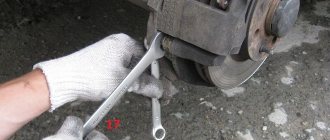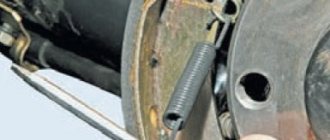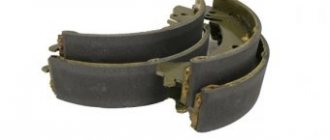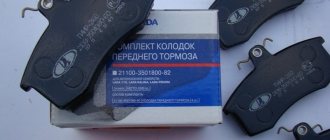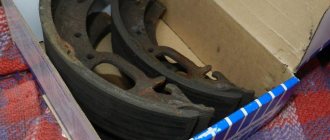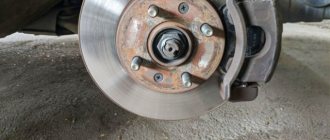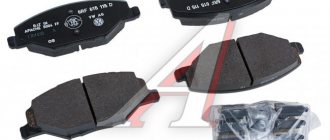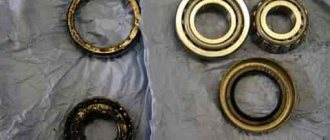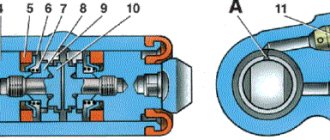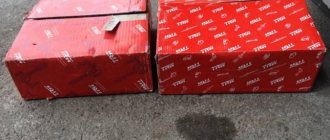Brake pads, like car tires, wear out as you drive and require periodic replacement. The peculiarity of the car’s braking system is that the load during braking is unevenly distributed on the front and rear axles. The front wheels, and, accordingly, the brake pads, experience greater loads than the rear ones. This means that they also have to be changed much more often. The front brake pads on Kalina are replaced two to three times more often than the rear ones. To do this, you can contact specialists or do the work yourself. In the latter case, you must have a set of standard tools and new front brake pads. The procedure for replacing front pads on a Kalina equipped with and without ABS is the same.
Reasons for replacing brake pads on Lada Kalina
The main reasons for replacing pads are natural wear and premature failure. Driving a car with worn or faulty pads is not allowed, as this can lead to an accident due to reduced braking efficiency. In order to replace the pads on time, you need to pay attention to such symptoms of failure as an increase in braking distance and extraneous sounds when stopping the car (the pads on a VAZ rattle, scrape, whistle).
Brake pad wear can be caused by poor-quality composition of friction linings, malfunction of the working brake cylinders and frequent emergency braking. The specific service life of the pads depends on a number of factors, but according to the recommendations of automakers, they should be changed after every 10–15 thousand kilometers.
You need to change the pads in pairs, even if only one of them is worn out.
How do you know when it's time to change your brake discs?
It will tell you the behavior of the car. The braking distance increases, the pedal becomes less informative, the car may pull strongly in one direction, and the steering wheel will shake. All this indicates critical wear, it is worth thinking about and checking the brake system.
With a lot of wear, more than 50% of the surface, the cylinders in the calipers extend to their maximum height (too far) - this can lead to warping, jamming, and even a caliper leak (when some of the brake fluid leaks out). Also, a thin, worn-out pad disc will heat up very quickly, literally red-hot - the braking efficiency will drop significantly, and if it cools quickly (driving into a puddle), it may even crack, and this is very dangerous when driving.
You can determine the thickness yourself. Just take the operating instructions for your car, or download it on the Internet. Then we simply remove the wheel and check the wear. This can be done even without special tools, just look at the top “edge”, it usually protrudes (a kind of maximum mark) and gives you an idea of wear. It is enough to simply measure the depth with a ruler; if it is more than 2 mm, replacement is definitely needed.
If you want to accurately measure wear, you need to take a caliper and measure it on the sides. Then compare with the recommendations for operating your car.
Both need to be changed at once (on the same axis), you cannot replace one and leave the other, so you will unbalance the car when braking.
Features of replacement on a car with ABS (ABS)
When installing pads on a Lada Kalina with an anti-lock braking system (ABS) installed, it is important to take into account several nuances.
- Before starting the replacement, you will need to tighten the ABS sensor so as not to damage it when removing the old pads. The sensor is mounted on one screw, which can only be unscrewed using a deep E8 star-head.
- When removing the brake drum from the mount, you should be careful, since there is a built-in ABS sensor disc underneath it. Damage to the disc may cause the braking system to malfunction.
Preparing to replace the AP
Having determined that the TD is faulty, you need to prepare to change them yourself. To do this, you first need to buy a new spare part from a car store.
When choosing brake discs for his car, the car owner must take into account his driving style. Does he like to accelerate sharply and actively maneuver? How often does he use the brakes? He drives a lot around the city or mostly intercity trips on the highway.
The spare part from which manufacturer you need to buy depends on these factors. Discs can be standard or sports.
- Standard TD - made of cast iron, the casting is processed on a milling machine. They are ventilated and non-ventilated. Without ventilation, it is a single disc that is pressed on both sides by brake pads. A disk with ventilation is easy to distinguish - it is two disks connected by bulkheads. Ventilation occurs during movement due to air entering between these pancakes. Some of the respected manufacturers of these products are Bosh, Zimmerman, ATE.
- Sports TD - made of durable and ultra-strong gray cast iron, as well as austenitic stainless steel. These are considered to be more durable products that can last much longer and with more aggressive driving. Such discs are produced by EBC, DBA, Brembo.
This rule is explained by the fact that unequal weight of the same type of spare part on the wheels of the same axle will lead to loss of directional stability.
Thus, for repairs, two or four TDs are purchased, but in no case one or three.
In the garage or at a special technical site, the tools and materials needed for repairs are prepared in advance.
- Jack and wheel wrench.
- Keys to "13" and "17".
- Ratchet wrench.
- Large flathead screwdriver.
- Thin flathead screwdriver.
- Clamp.
- A piece of wire to fix the stupor.
- Hammer.
- WD fluid to unscrew stuck fasteners.
- Brake fluid, in case of bleeding the brakes.
- Rags.
Place the machine in a hole or on a prepared level area. Decide in advance whether the rear brake discs need to be replaced or only the front ones need to be replaced. This determines how to jack up the car. Raise the entire side or just the front wheels.
After raising the car with a jack, remove the wheel using a balloon. Clean the released brake mechanism and the surface of the hub from dirt and oil using a brush and rag.
Which ones to choose
Today in auto shops and at the car market you can find pads for Kalina from dozens of manufacturers, some of which are either uncertified products or even fakes made in the nearest gateway.
It is better to buy brake pads in specialized stores, requiring a quality certificate for the purchased product. As for the manufacturer, it is better to give preference to original spare parts.
Front VAZ brake pads for Lada Kalina have catalog number 2110-3501080, and cost between 320-400 rubles. A good alternative for them are analogues from foreign companies such as Pilenga, ABS, Bosch, Ferodo, Master-Sport, Hella, Delphi and others.
The original rear pads for Kalina are numbered 11180-3502090-55. Their cost is 500-650 rubles.
Recommendations
Comments 20
This is the first time I’ve seen the pads changed like this...
Well ok, I boosted my drive :)
Why unscrew the bracket fastening? there are two bolts, they seem to be 13 or 14, you unscrew one bolt and everything is removed to the side
These are innovative repair methods.
By the way, a good method!
It may turn out that one of the best and most faithful!
Current Torxes tend to sour there so much that they eventually break off(
There was sarcasm above!) There, the initial tightening force of these bolts is 15 kgf.m each, which are also M12x1.25 (plus the boiling of these bolts, as you correctly noted), versus 3.8 kgf.m each with M8 threads and which should be changed every replacement pads ))))) So this is innovation as it is!)
I have pads in front. They've been running for over 60 tons now and now they brake well and don't whistle, I bought them in Ukraine in 2013. I’ll change the company, I’ll have to remember the company)
Everything is correct and beautiful, but the pads themselves are crap, they don’t really have brakes, and the disc eats up a lot.
I always took Ferodo in green packaging, the pads are soft without asbestos, the discs do not eat or buzz. The only negative is that they generate a lot of dust, and they last for 20-25 thousand.
Sorry for interfering in someone else's conversation. Ferodo-Target Federal Mogul has not released for many, many years. Everything that is sold is a bare and unsafe counterfeit.
Come on, tell tales, these pads are installed from the factory as the first pads on Kalinas, Prioras, Grants. Does the factory knowingly accept counterfeit products?
They have never installed this on a VAZ... Only Ferodo-Premier. And not for long...
I say again, don’t tell me what you don’t know.
I say again, don’t tell me what you don’t know.
There really don’t seem to be any green or red ones www.autodela.ru/main/top/news/Ferodo_new_pack if you see any, check for authenticity kontrafakta.net/Ferodo/ko…odki-diskovye-fdb527.html and in general they write that the products are dangerous , they really wanted to supply them to VAZ, but VAZ refused them as low-quality dangerous non-braking products, info from here www.tiir.ru/upload/smi_o_nas/avto_r_0116.pdf
Sorry for interfering in someone else's conversation. Ferodo-Target Federal Mogul has not released for many, many years. Everything that is sold is a bare and unsafe counterfeit.
I support. Ferodo-govngo. I installed it once and then when I was drunk, I drove 25,000 after my family.
I skated 115 thousand on green Ferodo, and I never regretted that I installed them.
Overview of individual elements
Diagram of the Kalina brake system:
| 1, 5, 13, 16 | Brake mechanism of the Kalina front wheel, including pads, caliper, disc, cylinder |
| 13, 16 | Brake mechanism of the Kalina rear wheel - pads, drum, cylinder |
| 2, 6, 12, 17 | Hoses going to the cylinders |
| 3, 7, 11, 18 | Tubes |
| 4 | Brake Master Cylinder (Brake Master Cylinder) |
| 8 | GTZ tank |
| 9 | Vacuum brake booster (VUT) |
| 10 | Brake pedal |
| 14 | Fluid pressure regulator in the TC of the rear wheels |
| 15 | Regulator knob |
GTZ and brake pedal
The main brake cylinder has not undergone any changes compared to previous Lada models like the VAZ-2110. It is attached to the vacuum brake booster and the force from the brake pedal is transmitted through the VUT.
On top there is a tank with two sections and with measuring notches to control the liquid level. A sensor located in the reservoir lights up an indicator on the dashboard when the brake fluid level drops.
General information
First of all, it should be said that all work on organizing a sewage system in a house comes down to the following work:
- Arrangement of external sewerage - this includes everything that is located outside the house. This is a pipeline and a septic tank or cesspool. If there is a centralized sewerage system, the work is greatly simplified.
- Installation of internal sewerage - this work includes the installation of a riser, a drain pipe and wiring to the bathrooms. First of all, you should deal with the arrangement of the internal system.
Of course, to build the system, you can turn to specialists for help, however, if you do this work yourself, you can save a lot of money. There is nothing overly complicated about this, the only thing is that you must strictly adhere to certain rules and requirements that apply to such installation work.
Vertical elements of internal sewerage
The layout of the sewer system must correspond to the layout of the house. True, even when planning it, it is desirable to compactly arrange the premises to which water will be supplied and drainage will be carried out.
Such premises include:
- Kitchens;
- Bathrooms;
- Bathrooms;
- Laundries, etc.
The compact arrangement of these rooms will simplify the installation of the system. The best layout option is when all plumbing fixtures can be connected to one collector, through which the wastewater will flow into a septic tank, cesspool or central sewer.
Horizontal sewerage elements
If the house is large and there are several rooms with a water supply and drainage located in different parts of the building, experts recommend using a sewer system with several septic tanks or cesspools. In addition, if the house has two or more floors, it is necessary to install risers.
